Saturday, June 30
A New Logo for the Church Music Association of America
This is never clearer than at the Sanctus, where we sing their words Holy Holy Holy, Lord God of Hosts (that is, we would if it were properly translated) to precede the arrival of Christ on the altar with the Words of Consecration. It is a setting of this chant (from the ancient Missa Orbis Factor) that appears on the angel's scroll, reflecting, along with its acolyte's garb of amice and alb, the mystical reality of Christian worship.
I can thus think of no better symbol--even better than the organ, queen of instruments--to represent our ancient musical heritage, going back to the early Church, to the rites of the Temple, and the songs the angels have sung around the throne of Grace since God brought them into being.
The CMAA was quite happy to listen to all my suggestions and eagerly accepted the finished logo. The CMAA owns the copyright to the design, so I cannot reproduce it here, but you can find it among the photos of their Flickr account, as well as on page 5 of the Summer 2007 edition of Musica Sacra, if any of our readers subscribes to that fine journal.
Thursday, June 28
Motu Proprio as Ressourcement
This influence on Ratzinger, I think, helps to explain what he is about to do with the liturgical motu proprio. Few of informed mind would accuse Benedict XVI of being a "traditionalist" in the usual implications of this term, and indeed he would reject such intra-Church labels as unnecessary and indeed highly problematic ideological intrusions on the unity of the Catholic faith. This would then suggest that he is precisely, and in some ways ironically, offering a broader use of the Tridentine Mass, and a more positive image thereof, not as so much of a return to past use for its own sake but precisely in order to bring about a healing in the tradition, to separate tradition in its proper sense from its distortion at the the hands of ideologies, both in traditionalist and progressivist forms.
To illustrate my point, I refer to Fr. Mark Massa's penetrating historical and sociological study Catholics and American in Culture, in which the Jesuit analyzes, among other things, the First Sunday of Advent, 1964, that is, the first day that "the changes" in the liturgy began to take their sweeping effect. This is, in some sense, precisely when "traditionalist" and "progressivist" camps started to stake out their territories in the Church, to wage the "liturgy wars" in earnest, and we have been with them ever since, less so in some places than others. This is what gave us the clown Masses on one end and unnecessarily austere and recidivist Tridentine celebrations on the other. It is to this point, then, that we must in a sense return and seek healing, seek the organic development that for various reasons did not occur at that particular point in time. There are places, indeed, that can help us, like Corpus Christi in New York, places that implemented "the changes" but indeed continue to be homes to highly traditional and beautiful worship without the baggage attached to traditionalism.
The "Tridentine" Mass confronts us, then, with tradition - tradition in need of revitalization in many ways, but a great tradition nonetheless. It confronts us also in a tradition in which we are not defined by being particular sorts of Catholics but by being Catholic, and invites us to learn how to do this again without grinding our ideological axe. It invites us to return to the moment when it began to be violently abolished rather than gently modified, and to bury the pain and fear that have resulted on all sides since then, rather than to take it out on others. To forgive absolutely and free of charge, despite temptations to hold grudges and to speak bitter words. Such actions would only confirm and deepen the notion that tradition is equal to traditionalism, something that comes off as negative and ideological, unwelcoming and with an axe to grind.
We ought, then, to return to the moment symbolized by that First Sunday of Advent, with a mixture of gratitude and trepidation - gratitude for the second chances the Lord offers us, trepidation about repeating the mistakes of the past and letting the wounds of time open again instead of healing. We ought to place ourselves in this time precisely to seek what Vatican II offered us - a true sense of lay empowerment, not the forced "People of God" rhetoric of the 1960's but the notion that if we don't like the way the liturgy is celebrated, to do something about, to help bring about an organic development. We see the fruits of this already in things like this past weekends CMAA conference. As laypeople, we should seek neither to ensconce ourselves in an old-fashioned "Father knows best" clericalism nor in a newfangled but essentially similar clericalism of the lay where priestly functions are arrogated to others. Rather, we can take our proper place as people with something to say and indeed to offer for the sake of good liturgy, for the glory of God.
This means, then, forsaking agendas, forsaking demagoguery and triumphalism. We should neither cling to every iota of past forms nor seek to create ever new and more insipid forms. Rather, what the liturgy invites us to do is to live in illo tempore, in the time of our encounter with Christ in which he speaks to us, and in this time learn to worship him in spirit and in truth. In so doing, we must in a sense return to 1964, not on our way to 1570 or 1970 but on the way to an encounter with Christ and a Ressourcement of our liturgical tradition that is ever ancient but ever new.
Rumor: The Return of Lay Cardinals?

A friend passed along this article on Rumors of Re-Instituting Lay Cardinals.
I am trying to check out an astonishing rumour I've heard - I stress it is just a rumour at present and really barely bloggable, never mind reportable - that Pope Benedict plans on reviving the ancient office of lay cardinal... it would be an extraordinary story if true.
Matthew and the Shrine bounced this idea around about 4 years ago. In the end, given that cardinals are properly the honorary clergymen of Rome, it didn't seem like a great idea: how much good comes from the clericalization of the laity? What clerical status would be imputed to lay-cardinals? Could women be lay cardinals?
As outlandish as it sounds, the journalist says the rumor is surprisingly credible:
I could never have anticipated the level of truth they discovered in the rumour, and the machinations behind the rumour.
The last lay cardinal was Teodolfo Mertel. His picture, below, answers some of the immediate questions of, well, what would a lay cardinal wear?
Perhaps MOST unbelievable, after the very public papal scolding that the out-going British Prime Minister received just days ago, rumors also suggest that "the first two lay cardinals appointed will be our own Tony Blair, and France's Jacques Chirac." That is so completely ridiculous that it is probably being floated by people opposed to a lay cardinaliate, in order to sink the whole deal.
The plausible reasoning for lay cardinals, in the present pontificate, would be, as Ruth Gledhill suggests, not simply "to empower the laity" but, rather, to offer dedicated laymen the prospect of a way to make a career for themselves in the Church by means of fidelity," so that some would not make their careers as dissidents." The idea sounds outlandish, but that rational does have a Ratzingerian ring to it.
We'll see?
Let There Be Dancing in the Streets, Drinking in the Saloons, and Necking in the Parlor
Si è svolta ieri pomeriggio in Vaticano una riunione, presieduta dal Cardinale Segretario di Stato, in cui è stato illustrato ai rappresentanti di diverse conferenze episcopali il contenuto e lo spirito dell’annunciato "Motu proprio" del Santo Padre sull’uso del Messale promulgato da Giovanni XXIII nel 1962. Il Santo Padre si è recato a salutare i presenti e si è intrattenuto con loro in un’approfondita conversazione per circa un’ora. La pubblicazione del documento – che sarà accompagnato da un’ampia lettera personale del Santo Padre ai singoli Vescovi - è prevista entro alcuni giorni, quando il documento stesso sarà stato inviato a tutti i Vescovi con la indicazione della sua successiva entrata in vigore.Zuchetto-tip to Zadok the Roman.
Tuesday, June 26
Holy Whapping Television Network (HWTN)
Monday
8:00 PM. How I Met Our Mother. This critically-acclaimed sitcom, based on the Protoevangelium of James, centers on St. Joseph as he tells his foster-son Jesus and cousin James the Less about how he came to chastely espouse the Queen of Heaven. This week’s episode: Barnabas the Sadducee (Neil Patrick Harris) tries to drag Joe away from his carpentry shop for a Purim party that promises to be legend—wait for it, and hope that you’ve got the right set of kosher plates since the next word is—dary.
8:30 PM. The New Adventures of St. Christine. Sister Walburga tries to pry Christine off the convent chapel ceiling, where she has been stuck, quite voluntarily, since she jumped up out of her coffin at what turned out to be an awkwardly premature requiem mass.
9:00 PM. They've Got a Secret. Members of St. Gertrude the Severely Inflamed Extremely Traditional Roman Catholic Mission (Society of St. Pius I, Part II, Scene 4) compete to reveal the most-extravagant conspiracy theory involving Masons and their weather-altering machines, black helicopters, Mount Athos, the Bilderburgers (such a lovely couple), and the prophet Nostradamus.
9:30 PM. Dante Goes to Hell! Dante travels along the frozen lake of Cocytus in the ninth circle of the Inferno. (Originally titled The Divine Comedy, but the name was changed after genre confusion lead to a ratings slump last season.)
Tuesday
8:00 PM. Desperate Hapsburgs. Franz-Josef wonders why his no-good son Prince Rudolf has been hanging around that old dump in Mayerling so long. Franz-Ferdinand (the archduke, not the band) attempts to seduce Jessica Biel. Music by Franz-Ferdinand (the band, not the archduke.)
9:00 PM. Altar Boy Meets World. Eccentric next-door neighbor Fr. Feeney teaches Corey an important life-lesson revolving around extra ecclesia nullam sallus, like just about every other episode. (Warning: This series has been given a rating of TV-MA by the Congregation for the Doctrine of the Faith. Say ten Hail Maries after viewing, or go poke a badger with a spoon.)
9:30 PM. Savina the Teenage Martyr. Emperor Diocletian contnues to find another way to kill the seemingly indestructible and of course absurdly beautiful St. Savina (Melissa Joan Hart). This week: Razor-edged bamboo splints and something disturbing involving uncooked spaghetti, a tea-cosy and a video-loop of Santa Claus Conquers the Martians. Let's say it all together, boys and girls: Ew.
Wednesday
8:00 PM. The Latin Grammys. Hosted by Vicar-General Schmitz, ICR, direct from Gricigliano. Musical guest: the entire monastery of Solesmes. Awards are expected for Best Indult Solemn High Mass of the Year, Best Sequence, Best Novus Ordo Celebrant, Best Cantilation in Tono Recto, Most Nasal Chanting by a Frenchman, Most Mangled Latin Phrases by a Catholic Blogger, and Quietest Low Mass.
12:00 Midnight. Vienna Roast “Feast of the Holy Name of Mary” Cappuccino Infomercial. Hosted by St. Marco d’Avellino and Jan Sobieski on behalf of Holy League Enterprises, Inc. (Dang Venetians, they commercialize everything.)
Thursday.
8:00 PM. Luminous Mysteries Movie of the Week. Barat: Cultural Learnings of 19th Century Catholic France Make for Glorious Benefit Nation of America. In this movie film, busload of bewildered monoglot French nuns led by Sister Madeline Sophie road-trip across strange nation United States in borrowed Citroen bus in attempt destroy Freemasons successfully consecrate nation to Sacred Heart. Is nice!
10:00 PM. Rick Steves’ Travels in Vatican City. Part 300 of 471. Intrepid backpacker Rick continues his (at times creepily exhaustive) journey through the Holy See. This week: several air ducts, that boring stretch of corridor on the fifth floor between Cardinal Sodano’s old office and the water fountain, Ingrid Stampa’s medicine cabinet (mmmm, mercurochrome) and an empty drawer in Archbishop Ranjith’s office.
Friday
8:00 PM. Savina the Teenage Martyr. Special Encore Presentation. Today: rotating circular saws and a very large tub of flambéed cherries jubilee. Ick.
8:30 PM. It’s the New Radetzky von Radetz Show! Johann Strauss (Steve Smith) discovers he’s forgotten the count’s birthday and frantically tries to palm off a hastily-written march instead. Slapstick ensues when Klemens von Metternich attempts to build a pan-European coalition out of a tin can and six Firestone tires in “Diplomat’s Corner.” Gustav Klimt (Gordon Pinsent) makes a special appearance on the Schönbrunn Palace Word Game. And Harold and the Duke of Reichstadt go camping in “Adventures with L’Aiglon.”
9:00 PM. Bewitched. Fathers Kramer and Sprenger, O.P., and their really big mallet, pay a surprise visit to the Stephens residence. (This was, mysteriously, the last episode ever produced.)
Saturday
8:00 PM. Saturday Night First Vespers Movie: Holy Office Space.
And Fr. Torquemada said, "I don't care if they excommunicate me either, because I told, I told Cardinal Caraffa that if they move the dungeon one more time, then, then I'm, I'm getting myself lacized, or something. And, and I told the Archbishop too, because they've moved my prie-dieu four times already this Lent, and I used to be over by the door to the sacristy, and I could smell the incense, but then, they switched from the Swingline to the Boston thumbscrews, but I kept my red Swingline thumbscrews because they bound up the accused a lot better, and I kept the special spikes for the Swingline screws and it's not okay because if they take my screws then I'll set Castel Sant' Angelo on fire..."
Oh, You Say That to All the Altar Boys
She said, "You really did a good job up there--you looked almost Anglican!" She really does know how to flatter me.
Update. Note to those who have trouble with humor as a concept. This was a joke by Dawn, who is scrupulously orthodox, playing to my love-hate relationship with Anglican liturgical style, not some sinister conspiracy involving albino monks and cups of Earl Grey tea. Seriously, people, chill!
Monday, June 25
Benedict Visits His Library
The Tridentine Mass, the Congregation, and the Pater Noster
St. Bede's Studio has a letter from the Pontifical Commission Ecclesia Dei, dated March 26, 1997 and signed by Angelo Card. Felici.
Of particular interest to past Shrine discussions, the letter contains permission for the congregation to sing the Pater Noster at Solemn or Pontifical Solemn Masses.* The other permissions granted to indult Masses are also interesting, such as the reading of Scripture in the vernacular rather than Latin (presumably from the altar) or the abolition of the need for the celebrant to say the Gloria and the Credo apart from the choir (a repetition which I have always liked, myself). In light of a potential main-streaming of the Tridentine Mass with the eschatological motu proprio (it could come any time, but only the [Holy] Father knows the day or the hour), these permissions may become more relevant. Certainly, they will be hotly debated..!
* In those earlier discussions, I was incorrectly under the impression that, with the rubrical reforms of John XXIII, the congregation could sing the Pater Noster, but in fact this applied only at the spoken Low Mass and not at Solemn Masses. Of course, now that point seems moot.
(Click to Enlarge)
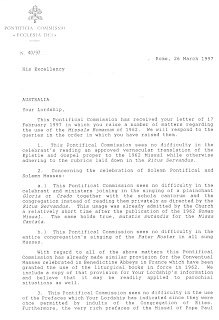

Sunday, June 24
Observation
Now, go and try and tell me men and women are identical in all respects.
Friday, June 22
Summer Reading, and a Tenuously-Related Excursus on Chesterton's Notre Dame Poem

Notre Dame Inspirations
Hannah Storm and Sabrina Weill
New York: Double Day
Hardcover, 170 pp.
As everyone knows, this blog is interested in all things Notre Dame. Which includes "Notre Dame Inspirations." The idea is interesting--to collect reflections on "Life, Spirituality, Football and Everything Else Under the Dome" from the most well-known alumni from this university.
These alumni include, of course, Fr. Hesburgh, Regis Philbin, Rudy, Charlie Weiss and the author, Hannah Storm (co-host of CBS' The Early Show). Thirty-two alumni contributed in all, the majority of them people whose names I did not immediately recognize. Non-Domers might not realize Joe Montana, Joe Theismann, and Phil Donahue graduated from Notre Dame.
I particularly liked the 6-page reflection by (Most. Rev.) Daniel Jenky, which should surprise no one. A Holy Cross priest, he was rector of the Basilica at Notre Dame before becoming bishop of Peoria, Ill. "If there was ever a place," he writes, "that our Catholic faith is so manifest, except maybe the Vatican, it is at Notre Dame... Notre Dame gives people permission to experience their faith. These days you get sometimes kids who come from 'Catholic lite' homes, but they seem to get there and something happens to the,. That happens year after year, time after time." It really does. Also, the picture of a scraggily-20-something-Br.-Jenky is awesome.
Of course, the whole idea behind the book, which I really do like, is for alumni to wax poetic about Notre Dame. I think that this phenomenon is something that only those who have lived at Notre Dame can fully appreciate: the beauty and uniqueness of the place makes us all a little sappy. Nonetheless, I'm comforted by the fact that a mind (and man) the size of G. K. Chesterton understood this sappiness, even dedicating a poem to the University (where he spent some time around 1930). The poem, The Arena, is subtitled "Causa Nostrae Laetitiae" (Cause of our Joy), a play on the Litany of Loretto that only seems like an exaggeration to people who attended Michigan State.
An excerpt:
I have seen, where a strange country
Opened its secret plains about me,
One great golden dome stand lonely with its golden image, one
Seen afar, in strange fulfillment,
Through the sunlit Indian summer
That Apocalyptic portent that has clothed her with the Sun.
She too looks on the Arena
Sees the gladiators grapple,
She whose names are Seven Sorrows and the Cause of All Our Joy,
Sees the pit that stank with slaughter
Scoured to make the courts of morning
For the cheers of jesting kindred and the scampering of a boy.
...
"Queen of Death and Life undying
Those about to live salute thee;
Not the crawlers with the cattle; looking deathward with the swine,
But the shout upon the mountains
Of the men that live for ever
Who are free of all things living but a Child; and He was thine.”
So, probably, the sort of sentimentalism found in this poem, and in this book, is only comprehensible to actual Domers. In that light, it would make a good gift to Notre Dame graduates, or to someone just now entering the school. It's a well-bound book, filled with high-quality photos of the alumni and of the campus itself.
$29.99, however, is really over-priced. Amazon offers it for $19.77, and at that price it would make a good gift.
Curt Jester Does It Again
Those readers who so loudly didn't appreciate the "When Catholics Drive Fast" photo I blogged a year or so ago should not click on the link.
Those who appreciate the famous "Mary's Fiat" photo definitely should.
Thursday, June 21
Book Reviews
Lucy, however, has a strong recommendation for All We Know of Heaven.
Wednesday, June 20
Worst Tabernacles Ever
Much to the chagrin of, well, all of us, he recommends that contestants seek out potential submissions at their local Catholic church. Lest anyone feel inclined to protest... "search your feelings, you know it to be true."
This is by far the worst submission:

:-(
Honestly, I didn't think this one was so bad:

Tuesday, June 19
Reflections from Another Whapster on Guidelines for the Pastoral Care of the Road
"Well," I explained, "it's really more about good road etiquette. They haven't gone and come up with any new sins." (I rather doubt anyone could invent a new sin, whether pope or Antichrist.)
"But the Vatican?" He was, quite respectfully, puzzled by the idea that the venerable office of the paparchy would have anything to say about something so topical as Road Rage.
In retrospect, I think I simplified things a bit too much--the document did make very clear that our actions have moral consequences, and a car, like anything else from a tub of Ben and Jerry's ice cream to the sight of a beautiful woman can be an occasion for both good or evil: your choice. That is news as old as the world, or probably older. I've been surprised, as a consequence, that so much has been made over this spiritually useful but otherwise unremarkable from an overlooked department of the Holy See, treated in many places less as an opportunity for spiritual growth than simply news of the weird. I guess it means people are listening--it is amazing how pope-watching has become so popular of late, even more than in the days of John Paul II.
But back to the Vatican's rules of the road. You'd think it would be easy to accept that that operating a multi-ton hunk of metal on wheels--capable of smashing itself to pieces against a concrete wall, capable of plowing into crowds and mowing down anything in its path, capable of bringing families together and bridging unbridgeable distances, capable of ruining or enriching life on so grand a scale, and in such a graphic and quotidian way--would be a matter that brought both rights and responsibilities. Certainly we would be shocked if someone didn't think drunk driving a crime--but the idea that it might be a sin is so distant as to be beyond quaint but simply puzzling. Maybe we resent the intrusion of another purported set of moral rules--but to see this document, or any document, as mere moralism misses the whole point of the Church's joyous guidance.
Perhaps it is the idea that the Vatican--or rather, a small department of it, at a distant remove from the Pontiff--might have anything to say at all at such a worldly activity, seemingly so separate from the spiritual life, is what surprises us. We forget, then, that the Vatican and the various national councils of bishops have many things to say about many topics, from genetically-modified organisms to grain subsidies. But, more profoundly, this also points to a bigger truth--that the Catholic Church is truly catholic, and as Chesterton once remarked, not only does have something to say about everything but must and can have something to say about everything and anything because it is her business to be involved in everything, and thus sanctify the world in which we live today.
Do the Dew
Amy asks, "As I have blogged and written before, many times, clerics and those in the church bureaucracy need to get their stories straight. Are we "the most highly educated laity in the history of the church" capable of making our moral decisions all on our own, without substantive Church guidance..or are we idiots who can't figure out what "dew" is?"
"Guidelines for the Pastoral Care of the Road"
Reuters is running a story that the Vatican has issued, today, a document on Christian driving.
I wasn't quite sure what to think of this, until I saw that Asianews, more reliable and much more sympathetic in matters Catholic than Reuters, was also running the story.
The document, not yet on the Vatican's website, is said to come from the Pontifical Council for the Pastoral Care of Migrants and Itinerant Peoples, which has issued documents on such things as Christian tourism, the pastoral care of Gypsies, and airport ministry.
In fact, the Catechism of the Catholic Church, produced by Joseph Card. Ratzinger (now Benedict XVI) and published under John Paul II in 1992, states that reckless driving can be a mortal sin in para. 2290:
"The virtue of temperance disposes us to avoid every kind of excess.... Those incur grave guilt who, by drunkenness or love of speed, endanger their own and others' safety on the road, at sea, or in the air."
Since the new document is said to suggest praying while driving, Catholics interested in automotive spirituality may want to visit the Sacred Heart Auto League, which promotes "careful, prayerful driving." By "liv[ing] out their love of neighbor through courteous and careful driving," League members offer reparation to the Sacred Heart of Jesus for the casual disregard towards the lives of others which wreckless driving represents.
Donations to the League fund missionary work in northern Mississippi. Check out the Sacred Heart visor clip.
Update
The document is now online.
Update #2
Seriously. Someone has to take the American Slang dictionary away from the Vatican's translators. Remember last year, when they announced that a certain prelate had "kicked the bucket"? "Hands in the air... give us the dictionary... no one gets hurt."
From Fr. Z:
The Holy See’s new document Guidelines for the pastoral care of the road from the Pontifical Council for the Pastoral Care of Migrants and Itinerant People and its president Renato Raffaele Cardinal Martino. After talking about "Street Women" and "Street Children" we get:
PART FOUR
THE PASTORAL CARE OF THE HOMELESS (TRAMPS)
Monday, June 18
From Of the Atmosphere of a Church, 1947
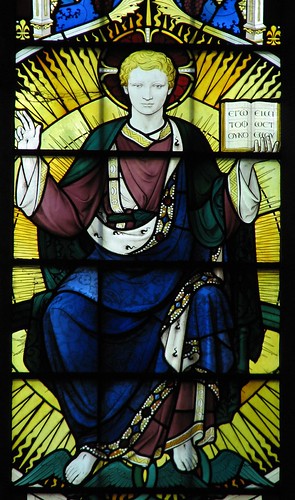
"To enter therefore a Christian church is to enter none other than the House of God and the Gate of Heaven. It is to leave all strife, all disputes [...] outside -- 'Thou shalt keep them secretly in Thy tabernacle from the strife of tongues'--and to enter here on earth into the Unity of the Church Triumphant in Heaven. It cannot be otherwise, since He Himself, who is the Temple of it, the Lamb slain from the foundation of the world, is there also. [...]
"It must, moreover, reduce to folly those terms of 'self-expression' and 'the expression of the age,' used to cover what is merely such incapacity and ugliness as every age has rejected. [...] The purpose of a church is [...] to move to worship, to bring a man to his knees, to refresh his soul in a weary land. That would seem to be the Creator's purpose towards man in giving him the beauty of nature, and it should be the purpose of all art. In art man partakes in this purpose of his Maker and objectively he brings the best of all He has given him to create beauty (in liturgy, poetry, music, ceremonial, architecture, sculpture and painting) to be the expression of his worship. For mankind in the mass the neglect of beauty spells the hardness and narrowness either of a puritan or of a materialist; though the saint and the mystic may pass directly, without the aid of external beauty of art, and even of nature, to God Himself.
"The note of a church should be, not that of novelty, but of eternity. Like the Liturgy celebrated within, the measure of its greatness will be the measure in which it succeeds in eliminating time and producing the atmosphere of heavenly worship. This is the characteristic if the earliest art of the Church, in liturgy in architecture, and in plastic decoration, and it is the tradition of all subsequent ages. The Church took over what is eternal in the Jewish and Greek temples, adapting and perfecting it to her use, developing and adding to it in unbroken sequence, and evolving new forms, some of which came to stay, and some of which needed correction. For the religion of Christ knows no moment of perfection here on earth, although it retains all perfections to which man has attained and rejects all imperfections of barbaric or evil days. It should have no use for the incapacities and crudities of primitive society in the invitation of which some have taken refuge today, this is rather a time to look into the rock whence we are hewn, respondere natalibus. While we cling to every loveliest form that man's work has produced just as we cling to every loveliestr flower of nature, we must again make the architecture of our churches in complete harmony with the Liturgy, as Rome has done so notably of late for its music. [This is clearly a reference to Pius X's motu proprio in promotion of chant--yet perceptively, Comper also sees both the benefits and the flaws that flowed from this sometimes-overrated ruling:] And yet, again, just as no moment is perfect, so no reform is pefect, for it will always go a little too far. The admission of later music and a stringed orchestra for the ordinary of the Mass at Barcelona on Easter Day, 1935, in addition to the unaccompanied plainsong and contrapuntal music, was no contradiction of the new ruling. For is there no room in the Kingdom of Eternity here for all manner of music that it has entered into the heart of man to conceive as existing there?
"And so it should be with architecture, the other handmaid of liturgy. No beautiful style should be excluded. But the plan, the 'layout' of the church must first be in accord with the requirements of the liturgy. [...] There is no need to apologise for doing so in architecture [...]
"And do we want originality? I quote Dr. Inge: 'What we call originality is generally the power to see old things in a new light--it is the reading of some open secret, as we know it to be in the natural Sciences.' [...]
~Sir Ninian Comper (1864-1960)
Don't They Understand

Source
Queen Elizabeth II being burned, in effigy
"If somebody has to attack by strapping bombs to his body to protect the honour of the Prophet, then it is justified," -- Pakistani Religious Affairs Minister Ijaz-ul-Haq
Don't such people understand that these suicide attacks have brought infinitely more scorn towards Islam and its founder than probably any other factor in world history? Are we really supposed to believe that a God whose honor requires the child-sacrifice of 12-year-old suicide bombers is somehow "great"?
Would the vast majority of the world harbor any suspicion or grudge against Islam if the threat of death at the hands of extremist attackers didn't exist?
Addendum
Mark Shea gives a charitable look at the frequent argument that "Islam has nothing to do with terrorism."
Friday, June 15
Enjoyable Thing to Do in New York #1,234
Then, respond:
"Yeah, that's a lot of tinfoil!"
Thing not to do in New York, #1,467
(It's nothing personal, guys. It just leads to a lot of repetitious explaining to your friends afterwards.)
I Smell the Scent of a Pontiff
Now Nappy Three may have been a bit of a kepi-wearing lounge lizard, but he had snappy taste in uniforms and a cute Catholic wife, and he smelled good, too. Those of you who knew me in college are still emotionally scarred for the time I dressed up as the parvenu Emperor for the architecture school's costume ball, but the theme was Eurotrash, after all. I wasn't like everyone else who just wore jeans and pleather. (My date went as Catherine the Great--anachronistic, but rather a fun combination, helped by the fact I just happened to own a full-size replica of the Russian Imperial standard at the time. We wandered around campus afterwards freaking everyone out with our appearance.)
...Where was I? Ah yes. Cologne.
I was amused to discover that apparently Napoleon III's fellow monarch, the redoubtable Pius IX, had his own official cologne which has been resurrected according to a now-very-long-dead-post on Fr. F's lively blog. It is, rather than being stuck with a goofy Calvin Klein-style name like Infallible (say it with a silly French accent), simply called The Pope's Cologne. Works for me. Though really, after all that incense gets into your simar, you really don't need additional scent.
Dappled Things - Soon to Be in Print!
The SS. Peter and Paul 2007 edition of Dappled Things is at the printers as I write. For all of you who filled out "Yes" on your survey when asked if you would be interested in a printed version of the magazine, there are only a couple of days left to subscribe! If you do not want to miss out on our historic first issue, stop by our website today! This will really be an excellent issue, and for only $19.99, it is not something you should pass up. Besides, all the cool people are doing it.Our first print edition includes pieces by Fr. Richard John Neuhaus, Peter Kreeft, Colleen Carroll Campbell, and Michael O'Brien on their favorite books, a select handful of splendid poems and stories, and a humble effort by yours truly as well on one of my favorite painters, the great Botticelli. Don't miss out!
Tuesday, June 12
Forgotten Architectural Styles V: Lecce, the Florence of Apulia
"Lecce, the provincial capital of Apulia, is the most beautiful and architecturally distinctive city on the south Italian mainland. [...] Despite its remoteness in the heel of the Iyalian boot, Lecce and its environs was a prosperous center of agriculture and trade with the East. Culturally, it remained more or less independent of both Naples and Spain, and one searches in vain for any easy explanation of its idiosyncratic architectural personality. [...]
"The Sedile [1592, Giuseppe Ricardi] embodies three characteristics common to the city's architecture: the unorthodox handling of the classical orders; the adoption of outdated elements such as the Gothic pointed arch; and the love of sculptural ornament. Here, the treatment of the corner pilasters is the building's most eccentric and memorable feature. Gouged out to reveal round columns within, these pilasters are as bizarre a redundant a combination of structural elements as can be found anywhere. The pilasters' abbreviated Corinthian capitals are a final 'mannerist' touch. [...] It is also one of the first Baroque buildings in Italy, if by the term Baroque we mean spirited and self-assured."

(Image source)
[On the church of San Matteo, Achille Carducci, c. 1644-1712]
"The facade [...] is more dramatic [than the church's interior]. It is more complex spatially and uses a more diverse repertory of architectural devices. Completed in 1700, its robust elevation is based on the Baroque tradition of curved planes and three-dimensional structural members. [...] The upper story of S. Matteo reverses the curvature of the one below. [...] Whatever its sources, S, Matteo is an amazingly free and unselfconscious structure whose temperament is purely Leccese. This is especially obvious in the surface decoration. Nowhere bute in this isolated coastal province could one find an entrance bay covered in fish scales, or cornice brackets covered with a dense carpet of tiny suckers. [...]
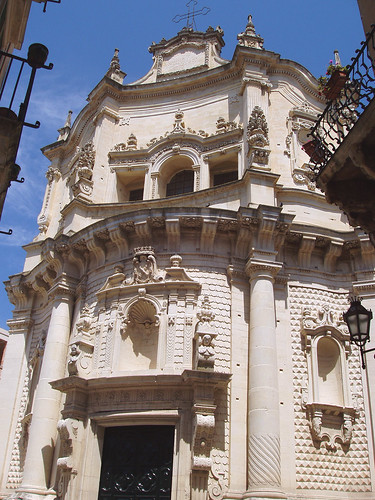
(Image source)
[On Giuseppe Zimbalo's Church of the Rosary, shown below, 1691-1728]
"...The columns display an unusual motif which is the architec's virtual trademark. A thick foliate band that marks the juncture of the cabling and fluting. Above the columns on the second story rest vases carved with massive fruit bushels and plump birds. Elsewhere on the densely-worked facade are embellishments that seem to spring from a different, more delicate sensibility. Over the doorway is a squarish relief carved in flat arabesque patterns that recall Islamic art."

(Image source)
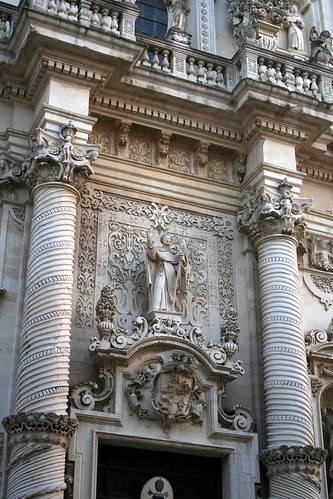
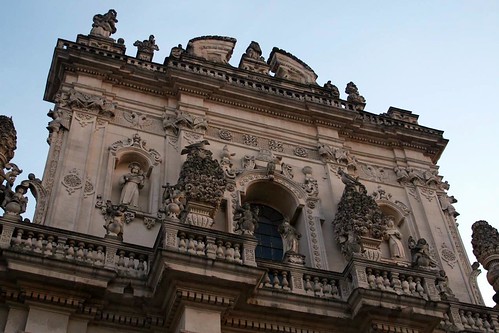
(Image source)
Other landmarks of Lecce are shown below, such as the Seminary, the Cathedral, the Piazza del Duomo, and various interior views and streetscapes:


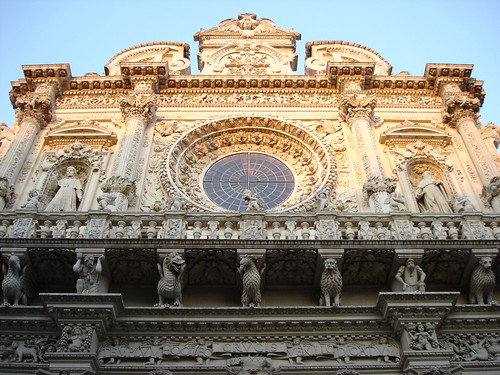


(Image source)

(Image source)

(Image source)
These, and many other similar shots, can be found at Flickr.
Monday, June 11
The History of the Mass, Part I
Here beginneth the noble History of the Exposition of the Mass.
For heart devout to understand what it is to say mass, also to conscrate the body of our Lord, the precious sacrament of the altar, it is to know that the mass may be comprised in four parts principal. The first part dureth from the beginning of the mass unto the offering, the second dureth from the offering to the Pater Noster said, the third part dureth from the Pater Noster unto the perception, and the fourth part dureth from the perception unto the end of the mass. As touching the first part, that is, the beginning of the mass unto the offering, it is to understand that the priest, which is as he that showeth the way of God to the people, ere he revesteth him with the chasuble, he beginneth and saith a psalm that is in the third nocturn of the psalter, the which psalm beginneth: Judica me deus et diseerne, and in the same psalm he asketh four things. The first is that he may be parted from all evil company, the second is that he may be delivered from all evil temptation, the third is that he may be of the Holy Ghost enlumined, and the fourth is that Jesu Christ give himself to be consecrated by him. And to the entent he may the more surely and devoutly consecrate the said sacrament, he confesseth himself generally of all his sins, saying his confiteor, by the which confiteor he showeth four things. First, he showeth himself worthy of redargution or rebuke, secondly, he showeth himself plein of contrition, thirdly, he requireth aid of them that are about him, that he may have remission of his sins, and fourthly, he demandeth of our Lord very absolution.
The priest, after, kisseth the altar, the which kissing signifieth unity and direction in showing how our Lord would unite or join our humanity to his divinity by great love, and take the church for his own spouse, wherefore the holy church may say thus: Quasi sponsam decoravit me corona, et quasi sponsam ornavit me monilibus. That is to say, that our Lord as his proper spouse, hath adorned or clad me with things precious.
For the full text, see here. More to come.

St. Justina of Padua. Fragment of a larger work by Bartolomeo Montagna, c. 1490. Metropolitan Museum of Art.
I am tremendously fond of this wonderfully elegant image of a beautiful virgin-martyr, particular the half-contemplative, half-skeptical glance she is giving the viewer, as if to say, "Is this the best you can do for God?" As I am currently at work on an image of St. Agatha (a real commission, no less!), I rather think it might do well to convey the serene yet sharp-edged and sharp-tongued contempt she had for the paganism of her judges, so vividly recorded in The Golden Legend:
Saint Agatha said: Thou sayst that they be gods because thy wife was such an one as was Venus, thy goddess, and thou thyself as Jupiter, which was an homicide and evil.Though, getting back to dear Justina, I will say the perspectival halo is mildly ridiculous.
Quintianus said: It appeareth well that thou wilt suffer torments, in that thou sayst to me villainy.
Saint Agatha said: I marvel much that so wise a man is become such a fool, that thou sayest of them to be thy gods, whose life thou ne thy wife will follow. If they be good I would that thy life were like unto theirs; and if thou refusest their life, then art thou of one accord with me. Say then that they be evil and so foul, and forsake their living, and be not of such life as thy gods were.
Quintianus said: What goest thou thus vainly speaking? make sacrifice unto the gods, or if thou do not I shall make thee to die by divers torments. Saint Agatha abode firm and stable in the faith. Then Quintianus did do put her in a dark prison, and she went also gladly, and with as good will as she had been prayed to go to a wedding.
On the morning Quintianus made her to be brought tofore him in judgment, and said to her: Agatha, how art thou advised for thy health?
She answered: Christ is mine health.
Quintianus said: Deny Christ thy God, by which thou mayest escape thy torments.
Saint Agatha answered: Nay, but reny thou thine idols which be of stones and of wood, and adore thy maker, that made heaven and earth, and if thou do not thou shalt be tormented in the perpetual fire in hell.

Image Source.
St. Justina is also shown in art with a unicorn, an animal of considerable Christological significance, and also an ancient symbol of purity in its own right. One particularly late appearance of this attribute can be seen in this delightful and placidly meditative painting of her with a kneeling donor by Bonvicino.

St. Justina, adored by the donor. Alessandro Bonvicino, 1530. Kunsthistorisches Museum, Vienna.
The Rev. Mr. Tony Blair
Sunday, June 10
Forgotten Architectural Styles IV: The American Polish Cathedral Style
And now, some photos of the Church of the Immaculate Heart of Mary in Pittsburgh, one of the more canonical designs I have seen, and one which resembles Rome's centralized-plan Sant' Agnese in Agone from some angles.
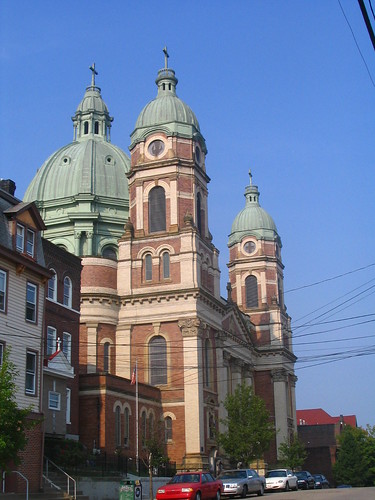
Image Source
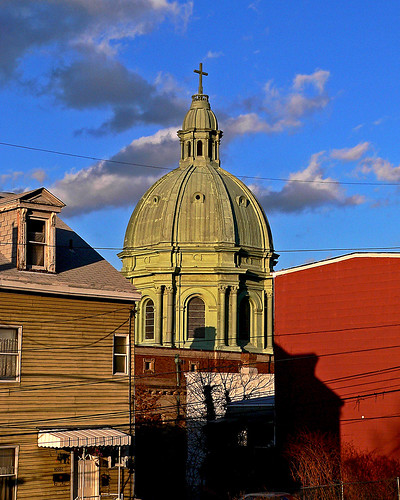
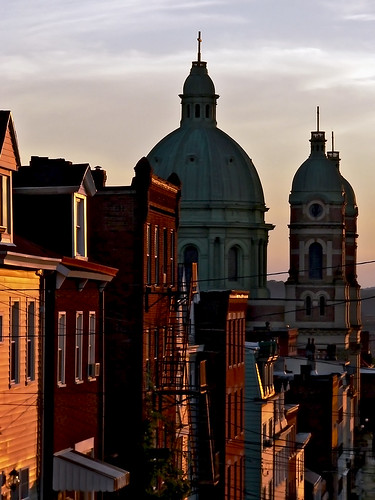
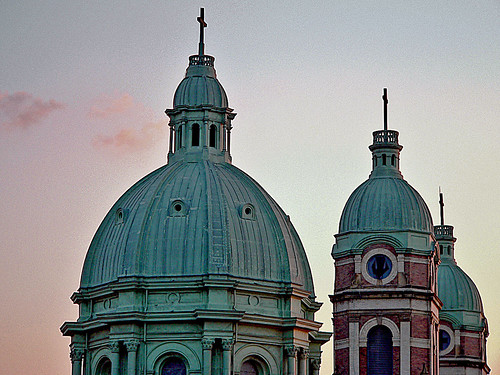
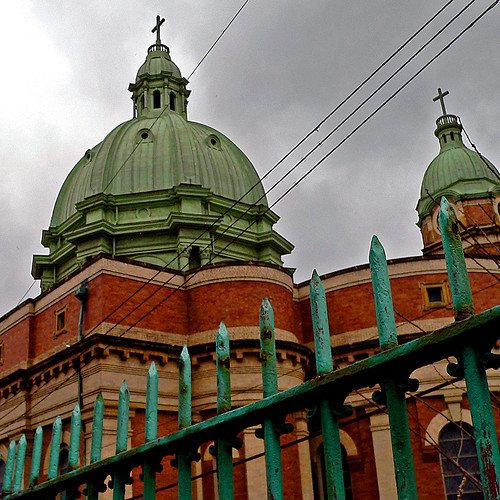
Image Source
A few more photos of it can be found via Flickr.
From Wikipedia:
Kantowicz writes in The Archdiocese of Chicago: A Journey of Faith: "The preference of the Polish League for Renaissance and Baroque forms seems more clear cut. The glory days of the Polish Commonwealth came in the sixteenth and seventeenth centuries when it formed the largest state in Europe... The architectural style of Chicago's Polish churches in Chicago reflect this, particularly the magnificent edifices of Worthmann and Steinbach built along the Milwaukee avenue corridor on the Northwest Side, reflected the renaissance glory of Polish Catholicism.I would be cautious to foster an absolute identification here with Baroque, as in many cases it has been heavily strained through 19th century folk-eclecticism and the necessities of using pre-fabricated materials and elements, though higher standards of style came with the work of later builders such as Schlacks or McCarthy.
Clearly a Baroque-like style was chosen deliberately, but it was rendered in a highlly contemporary manner, one that substituted a certain Victorian clutter for the original dynamism of the Baroque. Americans jump far too quickly to assume anything remotely ornate is Baroque and I have seen it applied in the oddest categories. Nineteenth-century eclectic is probably more accurate. Still, the results are pleasant, if occasionally puzzling. St. John Cantius is doubtlessly the most well-known church of the style but hardly the most ambitious, a title which clearly goes to the remarkable St. Mary of the Angels, whose interior, at least for America, almost approaches the Rome of the Renaissance, if not really Bernini.
And now, some photos of St. Mary of the Angels and others...
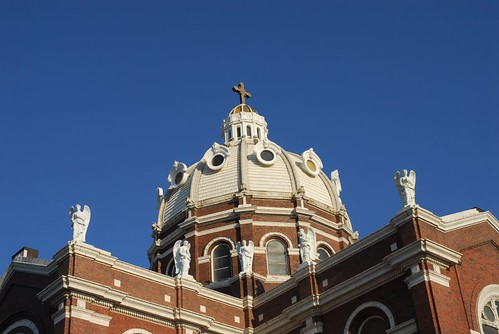
Image Source

Image Source
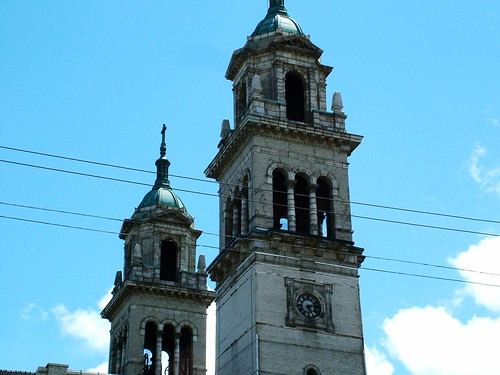
Image Source
Once again, Wikipedia:
Peter Williams in his book Houses of God: Region, Religion, and Architecture in the United States on p.179 writes "in Detroit and Chicago especially, a distinctive genre of church building emerged among Polish communities, the "Polish Cathedral". Where most Catholic churches were built in grander or humbler variations and Gothic and Romanesque themes popular across the country, the ambitious prelates in the great Lakes Polonias often chose to make monumental statements in the Renaissance style of their mother country. The scale of these structures was often enormous, both in the great size of these parishes and the episcopal ambitions of their clerical leaders... Still visible from the freeways, many of these "cathedrals" such as St. Stanislaus Kostka in Chicago now serve African-American or Latino constituencies while others have been closed by their Archbishops as no longer econmically viable.There is nothing so Catholic, I think, than seeing a parish where you've got Our Lady of Czestochowa on one side of the altar, and La Guadalupana on the other.
Caption Contest

(thinking) Ach, zese attempts to make me reveal ze date of the Motu Proprio are really getting ridiculous.
Under My Ombrellino

Driving home from Corpus Christi today, I couldn't help myself when I heard this on the radio...
When the sun shines
We’ll shine together (John 8:12)
Told you I'll be here forever (Lk 24:29)
That I'll always be your friend (John 15:13-14)
Took an oath I'll stick it out 'till the end (Psalm 132:11)
Now that it's raining more than ever
Know that we still have each other
You can stand under my Umbrella
You can stand under my Umbrella
These fancy things, will never come in between
You're part of my entity, Here for Infinity
When the war has took it's part (2 Titus 4:7)
When the world has dealt it's cards (John 1:10)
If the hand is hard, Together we'll mend your heart (Rom 5:5)
Saturday, June 9

"You zee, eef you turn eet just so, eet vill tell you ze location of ze Holy Grail."
"Amazing!"
(Source)
Friday, June 8
Why, you green-blooded..
Thursday, June 7
Corpus Christi in Rome
Happy (Real) Feast of Corpus Christi!

(Image Source)
To our American readers--and everyone else who will be celebrating Corpus Christi this Sunday--don't forget to start looking for a procession near you!
Wednesday, June 6
Cool!
American Church on the Front Pages
So I was really interested in the front page headline in section B, which read something like, "Area Schools Revive May Crownings." Juxtapose this with the headline from section A. Here we have Catholics awakening to the need to offer and articulate and enact the convictions and the faith that surrounds exactly the sort of compelling encounter with Christ I mentioned just above.
Even as we are in stiff decline in some areas (and, again, this decline must be mitigated by the strong Catholic presence now emerging in the South, as migrants from the Northeast and the Mexican south converge; Atlanta has, after all, perhaps the most seminarians in the country), we are beginning to remember that our identity as Catholics, professing a belief and an encounter with Christ which stretches to the Apostles, our existence depends upon articulating this encounter with Christ to others and to one another. This "Catholic identity" must be expressed, of course, in our thoughts and our actions (our belief and our morality), but it is also very effectively expressed and encouraged by our ritual and our traditions. That is why a headline about the re-emergence of things like May Crownings is perhaps the only thing that could make me smile after reading a headline about massive church closings: because we've got it, we've figured out the root of the problem--our identity rests in our proclamation of an encounter with God in Christ, and we're remembering how we used to make and live that proclamation. Which must be one of the strongest remedies for the present unhappiness.
A Big Deal, A Big Lie
That's a Big Deal, because it means that embryonic stem cells can be obtained without breeding human life for embryonic stem cells.
This is particularly timely, as today the House votes on a Big Lie, the
deceitfully mis-named "Human Cloning Prohibition Act", which would "legitimize the creation of human embryos by cloning, solely for use in research that will kill them."
That is falsely called a "cloning ban" because the cloned embryos would be forbidden from being carried to term, creating an underclass of human life which, rather than simply not being protected by the law, must be killed under the law.
This bill was introduced yesterday, to be voted on today, so that there would be no time for pro-life groups to protest the bill. Combined with the deceptive name, the whole bill is all the more slimy.
The great irony is that, the very day that the Congress tries to covertly authorize embryonic stem cell harvesting from human embryos, scientists announce that, not only have adult stem cells been the only promising source of stem cells, but embryonic stem cells can now be obtained without the abortion of human life--in otherwords, the covert bill was made superfluous.
Monday, June 4
Coping with Non-Vestigal Hoods
The liturgical cope is derived from the ancient Roman lacerna, a semi-circular garment wrapped around the shoulders for protection from rain. The ecclesiastical use is first attested by at the martyrdom of St. Cyprian in A.D. 258.
As a rain coat, the lacerna (naturally) had a hood. The hoods for most copes are vestigal--that is, no longer functional hoods, but a piece of flat, usually decorated, cloth where a normal hood would once have been:

Indeed, the existence of a hood (real or vestigal) is precisely what differentiates a simple mantle from a cope.
But, interestingly, in the first half of the twentieth century, there was a trend in England (particularly at Westminster Abbey) towards reviving use of an actual, non-vestigal hood in copes, as at the coronation of King George VI and other grand occasions:

I would be really interested in seeing other examples of the non-vestigal hood in modern copes.
Sunday, June 3
More Sicilia Barocca

San Domenico, Noto.

San Carlo Borromeo, Noto.

San Giuseppe, Ragusa Ibla.

San Benedetto, Catania.

Duomo, Catania.

Santa Maria del Soccorso, Modica.
Saturday, June 2
Forgotten Architectural Styles III: Sicilia Barocca

San Giorgio Cathedral, Modica, Sicily

Duomo, Syracuse, Sicily

San Giorgio, Ragusa Ibla, Sicily

Nun's choir, San Benedetto, Catania, Sicily


















